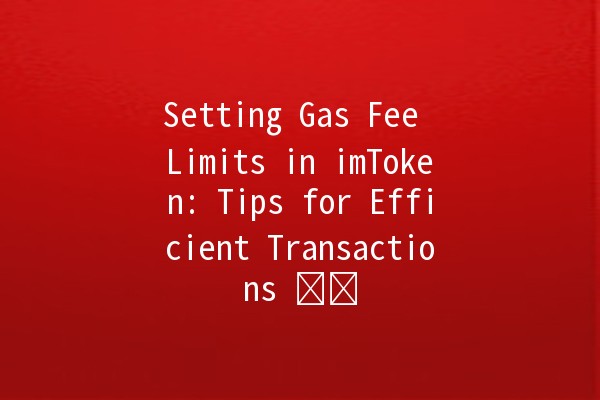In the everevolving landscape of cryptocurrency, understanding how to manage gas fees effectively is crucial for any user looking to interact with decentralized applications (dApps). Gas fees can greatly affect the efficiency and cost of your transactions, particularly on the Ethereum network. This article delves into the importance of setting gas fee limits within the imToken wallet and provides practical tips to optimize your experience.
Gas fees are transaction fees paid to miners on the Ethereum blockchain to process and validate transactions. In the imToken wallet, setting the right gas fee limit ensures that your transactions are executed promptly and costeffectively. When gas prices surge, especially during peak usage times, having the ability to adjust your gas fee settings can save you both time and money.

Tip: Leverage gas tracker tools like EthGasStation or GasNow to monitor realtime gas prices. These platforms provide insights into average, fast, and proposed gas prices which can help you make informed decisions.
Application: Before initiating a transaction, check these tools to understand current gas trends. For instance, if the average gas price is lower than usual, you might set a lower gas limit and still expect your transaction to go through quickly.
Tip: imToken allows users to manually set gas fees when making a transaction. Don’t just go with the default suggestions.
Application: If you're not in a hurry, set your gas fee slightly below the recommended rate. Example: If the suggested fee is 50 Gwei and the average is around 40 Gwei, you might set it to 45 Gwei, balancing cost efficiency and transaction speed.
Tip: Familiarize yourself with the difference between gas limit (the total amount of gas you are willing to spend on a transaction) and gas price (the amount you are willing to pay per unit of gas).
Application: For instance, if a transaction normally requires 21,000 gas and you set a gas price of 30 Gwei, your total cost would be 0.00063 ETH (21,000 * 30). Understanding this helps you set realistic limits based on your budget.
Tip: Transaction fees can vary significantly at different times of the day. Aim to execute transactions during offpeak hours.
Application: Use historical data from gas tracker tools to identify peak hours. Transactions made early in the morning or late at night often incur lower fees.
Tip: Stay informed about the latest trends and changes in the Ethereum network, as these can affect gas prices.
Application: Follow reputable cryptocurrency news sources and forums. Engaging with communities on platforms like Reddit or Twitter can also provide insights into potential gas fee fluctuations.
To set a gas fee limit, open your imToken wallet, initiate a transaction, and look for the gas fee option. You can then customize the gas price and limit according to your needs.
If the gas fee you set is too low, your transaction may not get processed. It could remain pending indefinitely until either the gas price drops or you cancel the transaction.
No, once a transaction is submitted on the Ethereum network, you cannot adjust the gas fees. However, you can cancel a pending transaction if you need to change the fee settings.
Gas prices can soar during times of high network traffic, such as when popular dApps are launched or major events occur in the cryptocurrency space. Staying informed can help you avoid these spikes.
Currently, imToken does not offer automated gas fee settings. However, some other wallets allow users to create templates based on recent transactions or preferred fee structures.
Gas consumption varies depending on the complexity of the transaction. For example, sending ETH consumes less gas than interacting with a smart contract, which requires more computational work from miners.
By implementing these strategies and tips, you can effectively navigate the complexities of gas fees within imToken. Optimize your transactions to save on costs and ensure your interactions within the Ethereum ecosystem are both efficient and effective. Always remember to stay informed and adapt to changing market conditions to make the most out of your cryptocurrency experience.